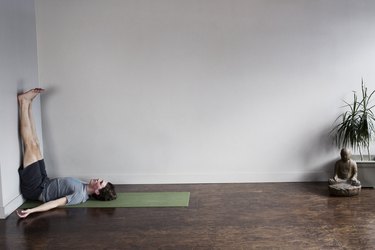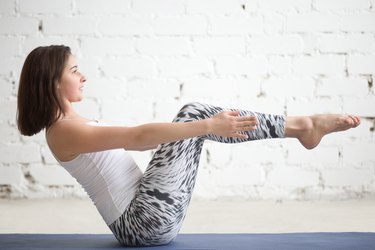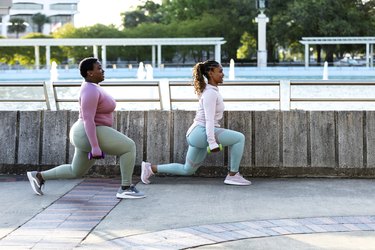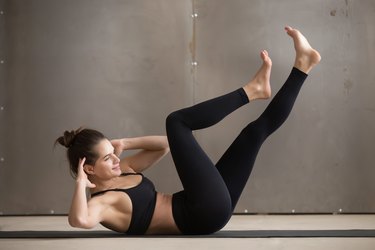
You've probably heard stretching before bed can benefit your sleep. And there's no better slumber-supporting stretch than legs up the wall pose (Viparita Karani). Yep, this yoga posture helps calm your mind and body.
But if you've ever attempted this pose pre-bedtime, you might've found yourself feeling more flustered and frustrated than zen.
Video of the Day
That's because even though it appears deceptively simple — you lie on your back with your legs straight against a wall — it can be quite difficult to position yourself like this, especially if you're lacking flexibility and mobility in certain areas of your body.
Here, Rosa Franklin, PT, DPT, CSCS, a physical therapist at Bespoke Treatments Seattle, explains what might be holding you back from achieving legs up the wall pose and provides ways you can work on nailing the posture.
If You: Have Difficulty Moving Your Hips Close to the Wall
You Might: Have Tight Hamstrings
"Legs up the wall pose is the same movement as bending over to reach for your toes, both of which require a sufficient amount of hamstring flexibility," Franklin tells LIVESTRONG.com.
But if you sit for prolonged periods every day (read: you have a desk job), your hamstrings, especially the area toward the top of the muscle group below your glutes, will tend to be tight. And this hamstring tightness may impact your ability to bring your knees toward your chest, Franklin says.
In other words, tense hamstrings will hamper your ability to move your hips closer to the wall during legs up the wall pose.
Fix It: Knee-to-Chest Stretch
"Use this single knee-to-chest exercise to temporarily increase range of motion at the hip and make it easier for you to inch yourself closer to the wall," Franklin says.
- Lie on your back with your knees bent and feet planted on the floor.
- Bring one knee toward your chest, placing your hands behind your thigh to gently pull your leg closer to your chest and deepen the stretch.
- Hold for 1 to 2 seconds, then release your leg.
- Continue this pattern for 30 seconds, then switch legs and repeat.
If You: Have Problems Keeping Your Knees Straight
You Might: Have Shortened Hamstrings
To perform legs up the wall pose correctly, you need a good deal of hamstring length, Franklin says. But, once again, long stints of sitting and/or inactivity can impair and limit these large leg muscles, shrinking their size.
"Hamstrings are usually shortened because they lack strength," Franklin says.
This weakness can present as decreased hamstring flexibility behind the knee, she explains. Because this limited flexibility makes it tough to keep your knees straight, it can produce problems during legs up the wall pose.
Fix It: Bent-Knee Hamstring Stretch
"Use this bent-knee hamstring stretch to get the back of your knees closer to touching the surface [of the wall]," Franklin says.
- Lie on your back with your knees bent and feet planted on the floor.
- Bring one knee to 90 degrees, then gently straighten your leg, placing your hands behind your knee for support.
- Hold for 1 to 2 seconds, then release your leg.
- Continue this pattern for 30 seconds, then switch legs and repeat.
If You: Have Back Pain or Discomfort
You Might: Have Guarded Hamstrings
If you've experienced recurrent hamstring injuries, your muscles might be guarded, Franklin says. Guarded muscles occur when a previously injured muscle (or muscle group) tenses up and becomes stiff involuntarily to prevent or alleviate pain, a July 2019 study in Pain Reports explains.
Guarded hamstrings can result in reduced hamstring flexibility, Franklin says. But this decreased hamstring flexibility can also create issues along the muscle and the knee and hip joints, Franklin says. You might feel this as discomfort or limitations in your lower back (and calves) during legs up the wall pose, she says.
Fix It: Jefferson Curl
The Jefferson curl uses weight to help improve your hamstrings' range of motion, Franklin says. It also builds strength and flexibility in the whole posterior chain (the back of your body), including your lower back.
- Stand upright on a small box or bench.
- With your arms straight, holding a light weight in your hands. You can use dumbbells, a kettlebell, a barbell, a weight plate or other weights you have available.
- Begin the movement by gradually rounding your spine from the neck down. First drop your chin to your chest, then round over through your chest and finally round your lower back.
- As you round, your arms should hang straight in front of your legs, close to your body. Use the weights to gently pull you into a fully rounded position.
- Round down as far as you can while keeping your legs straight. Ideally, you will be able to lower the weight past the box and below the level of your feet. If your hamstrings prevent you from going lower, just go as far as you can.
- You can choose to pause for 1 to 5 seconds in the bottom position and take several relaxed breaths.
- Finish the movement by slowly re-extending your spine in the opposite direction. First straighten out your lower back, then your chest and finally bring your head upright.


